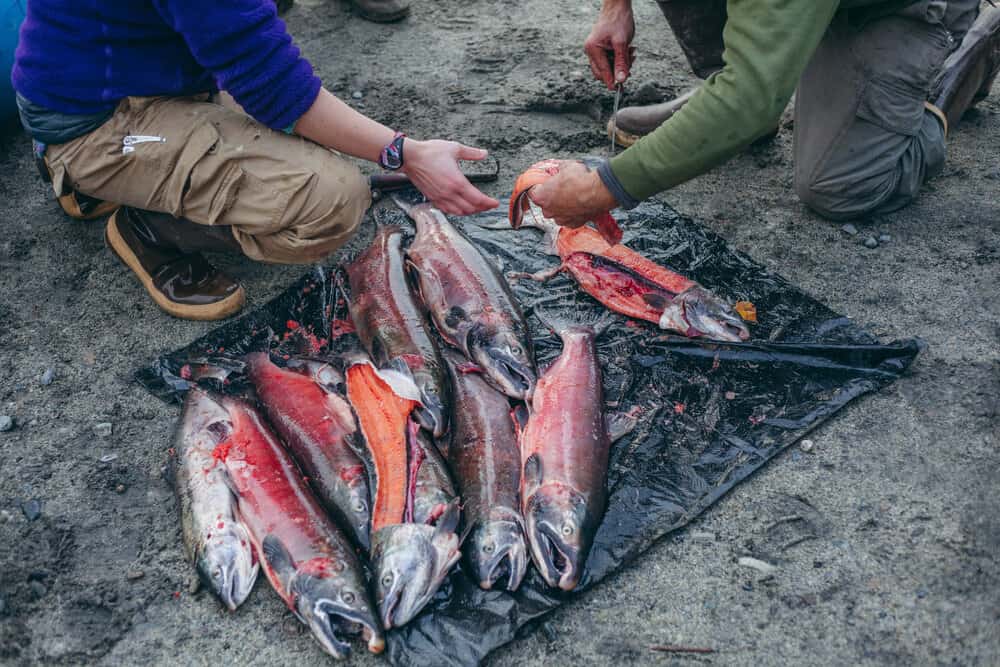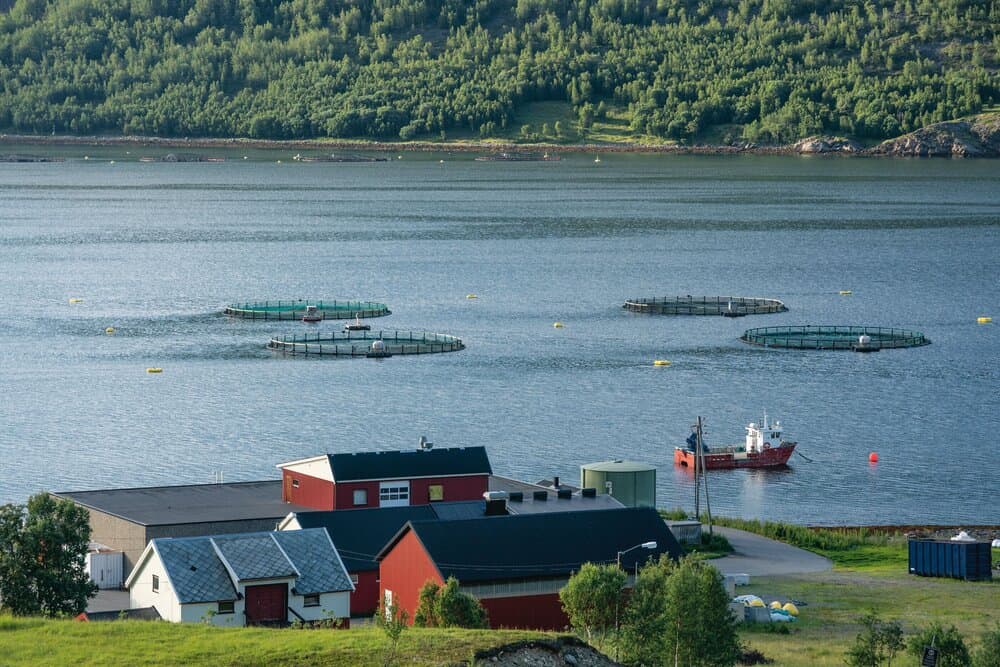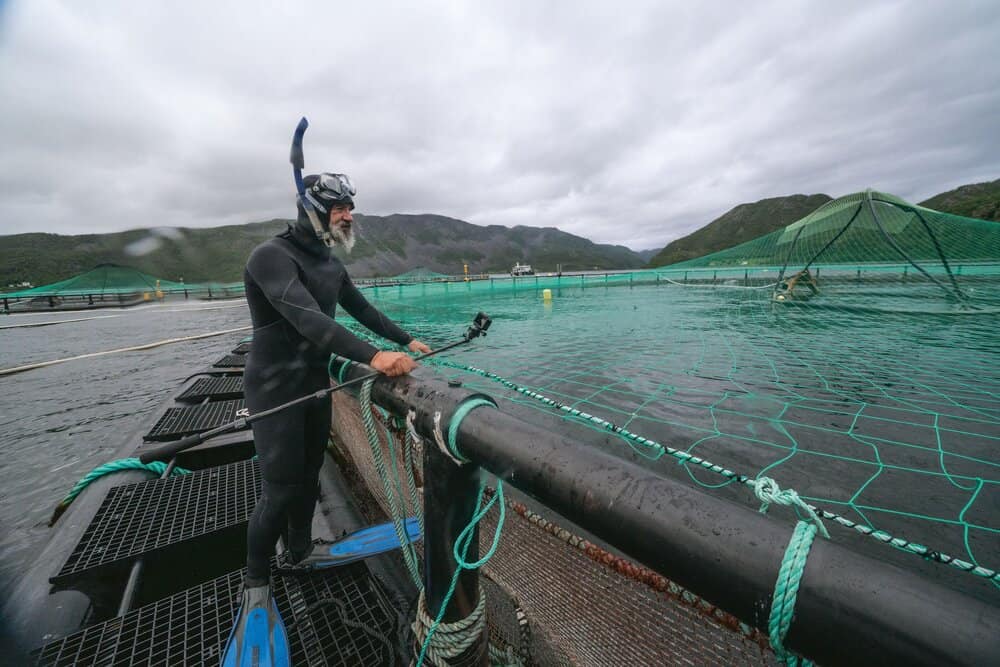Your cart is empty
PART I WORDS BY Charles Post
PART II WORDS BY Josh ‘Bones’ Murphy
PHOTOS BY Ben Moon and Charles Post
ORIGINALLY PUBLISHED IN MODERN HUNTSMAN, VOLUME THREE: WILDLIFE MANAGEMENT
PART ONE: EXTINCTION IS FOREVER
When salmon spawn and die, amazing things happen. The energy collected over months and years at sea is returned to the very waters they were born in. Their bodies feed the aquatic insects that will feed the next generation of wild salmon. Ravens, eagles, mink and bear will carry bits and pieces deep into the forest. Some of this will find its way into the soil to nourish the roots of ferns, alder and willow, which in turn will shade the creek, and help keep its waters cold through the summer months.
Some of the salmon will be carried into the ragged crowns of ancient cedar and spruce, where eagles have nested for generations. Young eaglets will be fed wild salmon so that they can grow quickly and strong. Some will end up in the canopy of these great trees, where entire gardens exist of wild berries, lichen, moss and liverworts. Below these towering gardens in the sky, wolves will pick up the scent of wild salmon. Coastal wolves have waited all year for their return. Like a bear, these sea wolves depend on these fish, so much so that their coats may turn a reddish hue from their salmon-rich diet. You see, wild salmon and the cool, clear waters that sustain them breathe life into these places. The fingerprints they leave behind reach far and wide across plants and animals, fungi and soil.
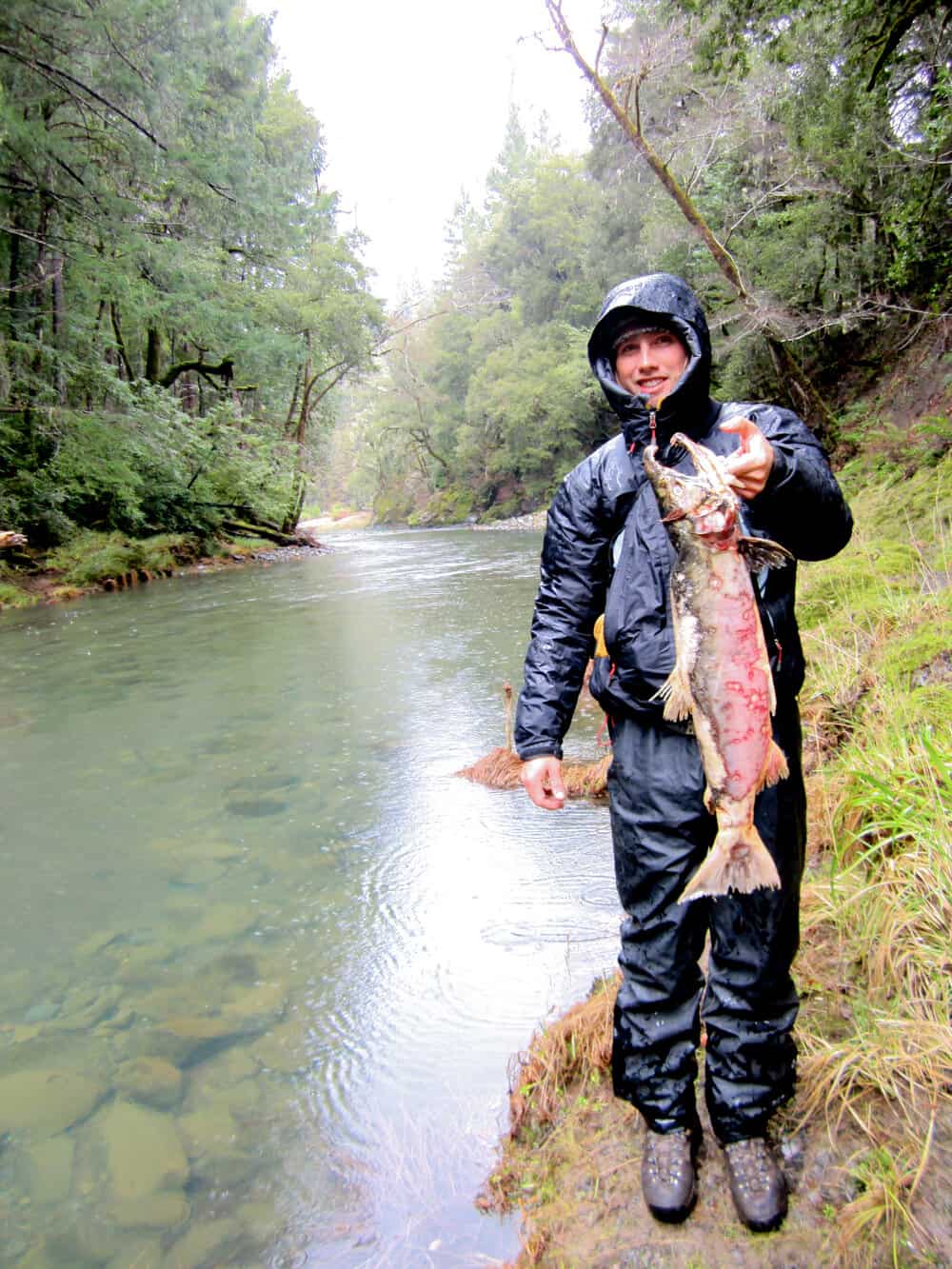
Back in 2010, I had a sticker on my car that read “No Pebble Mine.” As a young, excited freshwater ecology student at UC Berkeley, I soaked up lectures from professors who explained the mine in detail, what was at risk and why the mine should not come to fruition. Even then, nine years ago, it was clear this proposed mine had the potential to ruin one of the last wild places on Earth, where millions of salmon return each year to pour upstream to the very waters where they were born. In their natal waters, each of the millions of wild salmon would reproduce and die, releasing a massive pulse of nutrients that literally feeds ecosystems, from rainbow trout and soil to grizzlies, seabirds, and marine mammals offshore.
There’s no question that the rapid industrialization and taming of nature is making its mark on the world. Exponential growth seems to be what our world is after, yet a quick review of ecology will tell you that exponential growth doesn’t exist in the natural world: there are checks and balances to ensure long-term stability.
I’ve been thinking a lot about exponential growth lately, where we have to draw a line in the sand and think to ourselves, “It’s pretty darn good right here, so how can I hold onto this, find balance and establish something sustainable?”
With this in mind, there’s no way the proposed Pebble Mine is sustainable, mindful, or remotely worth the loss of a wild place brimming with life. It’s a place like no other on Earth, where millions of animals thrive, as well as the thousands of people who rely on these wild Alaskan salmon as they have for millennia.
They say hindsight is always 20/20. If this is true, then the obvious always becomes strikingly apparent. I can promise you nobody will look back on this mine in 100 years and say, “I sure am glad we destroyed one of the last great wild salmon strongholds so a massive international mining operation could extract gold and copper!”
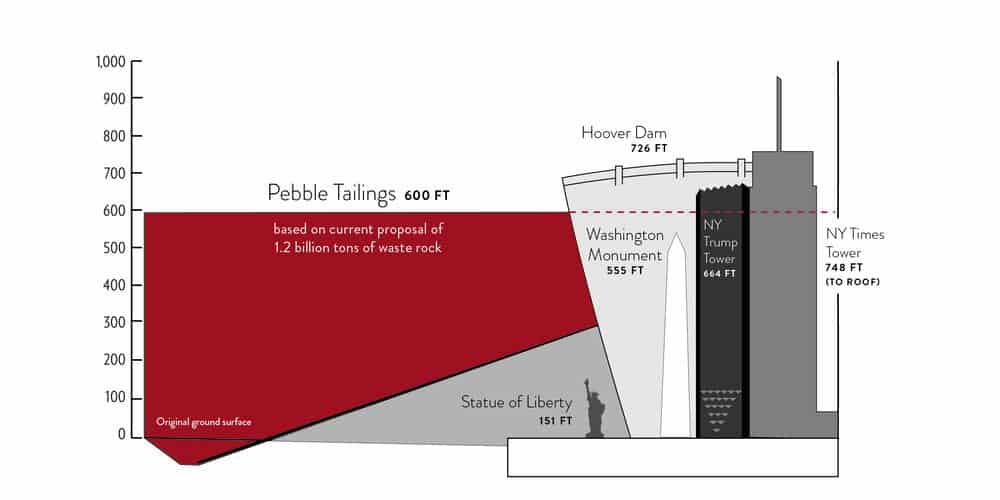
Having trouble picturing this mine?
Illustratively, the proposed Pebble Mine has some striking attributes. Phase I of the proposed Pebble Mine (as described in the Army Corps permit application) includes:
A pit over a mile in length, one mile wide and over 650 feet deep; selenium, a heavy metal byproduct of the mining process, will be discharged at levels toxic to fish and wildlife (there is no known treatment for this toxin).
A 600-foot dam to impound 1.2 billion tons of toxic-waste rock. These impoundments, known as tailings storage facilities (see illustration), would be some of the largest in the world and must impound the tailings forever behind an earthen dam — a highly unlikely prospect.
Impacts to over 80 miles of salmon streams and nearly 4,000 acres of wetlands near the mine site.
Destruction of an entire stream that supports coho, sockeye and chinook salmon.
An 83-mile-long transportation corridor with 65 miles of private two-lane road, an 18-mile ferry crossing, and eight bridges.
A ferry terminal on Lake Iliamna, located over the most productive sockeye salmon nursery in Alaska.
A private and large port facility on Cook Inlet adjacent to the McNeil River brown bear refuge and extending more than four miles into the inlet waters — known habitat for sea otters, endangered Cook Inlet beluga whales, humpback whales and seals.
A 270-megawatt power plant that could open the region to additional mining.
A 188-mile-long natural gas pipeline over land and under Cook Inlet and Lake Iliamna.
At closure, the tailings and the pit will have to be monitored and maintained in perpetuity, in a region where seismic activity and extreme weather conditions could trigger a catastrophic dam failure and release toxic mining waste down the Nushagak and Kvichak Rivers — the most productive salmon rivers in Bristol Bay.
This is likely just the beginning. Phase I of the project (over the first 20 years) will access only 12% of the deposit, most of which is low-grade ore. Are we to believe that they are going to walk away from the remaining 88% and leave the high-grade ore in the ground?
Update: As of August 2019, the EPA has withdrawn its 2014 Proposed Determination issued under section 404(c) of the Clean Water Act (CWA) for the use of the Pebble Deposit Area in Southwest Alaska as a disposal site associated with mining of the deposit.
“How can this damn mine be a good idea?”
How can this damn mine be a good idea? Sitting back isn’t an option. One of the world’s largest proposed open pit mines does not deserve a place in the heart of a watershed that sustains the planet’s last great wild salmon fishery. An invaluable piece of Earth is once again on the chopping block, guided by blind greed and nothing more.
For nearly 10 years, I studied salmonid ecosystems. I grew up with a stream in my Northern California backyard that supported wild salmon for millennia before they disappeared forever thanks to the Army Corp of Engineers, who transformed our little creek into a cement culvert devoid of life. I was raised in a house that had a small stream running just beyond the back fence. Wild salmon arrived each fall as they had for ages. We spent many days at sea, fishing the coastal waters for wild salmon. We lived just an hour north of San Francisco in a sleepy town nestled in the redwoods. Even there, wild salmon were a part of the ecology and social fabric. This isn’t just an Alaska story, this is a story that has relevance and roots from the far north to Los Angeles, from British Columbia to Kamchatka, from South Korea to Portland and everywhere in between. Salmon are the blood life of the Pacific and have been since time immemorial.
The optimist in my mind says, “Thankfully, we still have Alaska.” It’s true, my favorite place and time on Earth is August in that state, when the salmon return to the very waters they were born. Millions of them. It’s a reminder of what we have to lose, and in turn how much we have to save.
But that notion of, “Thankfully, we still have Alaska” is shortsighted. The plight of wild salmon is representative of the plight of our wild landscapes, wildlife, and the very ecosystems we rely on across the globe. This is a story that touches the waters of Maine, Scotland and Iceland, where Atlantic salmon live. This story impacts the docks and wharfs from Crescent City to Cordova, and it touches the forests that shade salmon water from the Hoh Rainforest to Santa Cruz and beyond.
What happens when we’ve destroyed the last wild salmon strongholds, when we look back on our actions and realize a mine was worth less than these animals?
If we can’t save one of the world’s most important commercially, socially and ecologically invaluable wildlife species, the ecosystems that sustain wild salmon and countless people, how can we steward and protect those species and ecosystems that don’t make the headlines, those slipping away out of sight and out of mind? It’s a test for humanity, one that will undoubtedly have repercussions that ripple across Earth.
PART II: THE LAST WILD FOOD
Since the dawn of the industrial revolution and the greater revelation of the value of the wild, salmon have been an icon of something bigger than ourselves. We’ve imparted salmon, and their cousins, trout, with an intrinsic worth and reverence that can border on religious zealotry for some. But there’s something to it, the idea of wild-ness, and salmon seem to occupy that space in our collective psyche. Like the bear, wolf, eagle and others on land, salmon have won our hearts with what they mean, not to mention how they taste. Unfortunately, history hasn’t treated them kindly.
The Columbia River separates Oregon and Washington and connects with the Snake river that flows from the spiny ridge of Idaho’s continental divide almost 1,000 miles inland. Less than 150 years ago, salmon runs on the Columbia River used to number 12 million, but the biggest runs in recent history recently have been just over two million fish. The Sacramento River gouges deep into California’s Central Valley and flows from the heights of the Sierra Nevada mountains into the San Francisco Bay and was the second-largest producer of salmon on the West Coast. Now, more than 95% of their spawning habitats are inaccessible behind dams, and less than 5% of the fish are wild. But what does it mean that less than 5% are wild?
For most people, a salmon is a salmon. Maybe they know the difference between “farmed” and “wild-caught” — a totally misleading marketing term that we’ll get to later — but they have no idea of the lengths we’ve gone to to make up for the loss of salmon caused by outright destruction of rivers and water quality. In our rush to settle the country, we dammed rivers for flood control, power production and irrigation. Rivers, the slim ribbons of life connecting terrestrial ecosystems with larger waters like lakes and oceans, were considered conduits for commerce, not something to be cherished and conserved. They were liquid highways that served a purpose of elevating humanity. Past that, they weren’t good for much.
In 1864, a diplomat and scholar from Vermont named George Perkins Marsh penned an essay entitled “Man and Nature” and became what many now describe as America’s first environmentalist. In his essay, he described the blight mankind had made on his cherished New England landscape and, for the first time ever, noted that humans had the great destructive power to alter the environment in irreversible ways.
One of the specific failings Marsh noted was the effect industry and agriculture had on rivers, and specifically the brook trout and Atlantic salmon he had fished for as a child. For Marsh, hunting and fishing were a measure of mankind’s grit. He, in fact, credited the courage and valor of the doomed Charge of the Light Brigade during the Crimean War to the vigor they had collected through time in the field as young men pursuing fish and game. While this may have been a stretch, the idea that the sedentary life of the industrialist can wring from the human soul the last of what is truly wild in us still resonates.
But Marsh had a plan. As a scholar and a man who understood the desire for progress, he believed that rivers and fish would never stand in the way. We couldn’t expect the wheels of development to grind to a halt for a few fish, so rather than try to stop the effects of industrialization, he proposed we help nature by adopting a new method of restoring fish to rivers. Artificial propagation in fish hatcheries was a relatively nascent “technology,” but one Marsh believed in deeply. By adopting agricultural methods of taking eggs from trout, and later salmon, raising them domestically, and releasing them back into the wild, he thought we could replace what was lost and infuse mankind with a renewed sense of purpose.
Belief in this method caught on and became one of the first nation-wide environmental movements. The idea that technology could “fix” the problem, and our successful models of domestication could be used to “enhance” nature, just made sense. Nature was a machine, and with our help, we could make it produce more for our unending demand. Five years after the Civil War ended, fish were being reared in all of the Northeastern states. Rather than protect rivers that supported wild fish, we could look beyond the larger problems of environmental degradation—the disease, if you will—and address the lack of fish as a symptom. Wild fish are the canaries in the coal mine for water quality, but instead of paying attention when rivers could no longer support them, we simply manufactured more and descended deeper into the darkness of human hubris.
Fish are the last wild food we eat at scale. Think about that for a moment. Over a billion people in parts of Asia and Africa still rely on wild fish as their primary source of food and commerce. When we order tuna, or cod, or crab, we don’t ask if it’s wild, we unwittingly assume it is. But that’s a real leap if you consider that to have wild fish, we must have a healthy environment and strict regulation and laws that limit overharvesting. We thought we could get around this with artificial propagation, but instead of helping wild fish, it’s driving them to extinction.
Most Pacific salmon in the U.S. — and almost all Atlantic salmon — now begin life in fish hatcheries. Over five billion salmon were raised and released into the Pacific ocean last year. Alaska, which many see as the last bastion of wild, leads the country with over 85% of all hatchery releases. And don’t be fooled by the “wild-caught” salmon promoted at the market — it doesn’t mean it’s actually wild, as over 90% of the salmon caught on the West Coast began life in a hatchery. You can’t have wild salmon without healthy rivers.
Salmon farms were the next technological advancement touted to save wild salmon. By eating farmed salmon, obviously we would harvest fewer wild salmon. But it didn’t really work out that way. Net pen salmon farming is cheap, as they simply float a net in the ocean and raise hundreds of thousands of fish in each. The problem is that there’s no control of what goes into and out of the farm. Parasites, food, feces, disease, chemicals and antibiotics all flow through the nets and into the ocean, and it’s having a devastating effect on the wild fish that pass by the pens. To keep it easy for ourselves, the farms are rarely far from shore, but that also means they are often squarely in the migration path of wild fish.
Atlantic salmon are functionally extinct in the United States, but their farmed counterpart comprise one of the single largest growth industries in the seafood business. Norway’s second-largest industry is farmed salmon, second only to oil production! Thanks to intensive fish farming, this once seasonally available fish is now available on every menu in nearly every restaurant nationwide, and in many cases, worldwide. We have to look hard to find wild salmon.
Some wonder why wild matters anymore, particularly in regard to salmon. Wild matters because it’s a measure of something bigger than us. It’s a recognition that mankind is not the only species on this fragile earth and that we cannot continue using the remaining natural resources as simply a store of commodities for the advancement of the human race. That may be a slap in the face for some, but it’s a hard truth.
Thousands of species rely on the health of wildlife, and that’s even more true with salmon. We cannot seek only to meet the demands of an ever-growing population with farmed and hatchery-raised fish at the expense of wild fish, or we will lose the very essence of the being we initially prized. If we don’t restore rivers too and protect the last of the wild salmon runs, we not only lose their beauty and diversity forever, we also doom ourselves to a perpetual cycle of manufacturing “wild.”
This reality, and the recognition of how few people realize the magnitude of the problem, was the existential question that led us to collaborate with Patagonia and make the new documentary film ARTIFISHAL, which premiered at the Tribeca Film Festival in April 2019. A chance meeting with Patagonia founder and conservationist Yvon Chouinard led to a project that took nearly three years to complete. But we were driven to expose what Yvon describes as the “arrogance of man.” As we struggled to tell a nuanced story that was largely in opposition to what most believe is beneficial, it became clear that we must embrace the total absurdity at hand. When viewed in context, our attempts to control and replicate nature are a total joke. It doesn’t take long for viewers to appreciate what is lost when we lose our faith in nature.
It’s more than food that’s at issue here, it’s the recognition of the greater impact we’re having on the entire Earth and the amazing wildlife it supports. As Yvon notes in the film, “A life without wild nature, a life without these great iconic species, is an impoverished life. If we lose all wild species, we’re gonna lose ourselves.” Hopefully, the film will provoke and confront us all with a disquieting question: Have we reached the end of wild?
See the full film ARTIFISHAL below. Learn more about it HERE.
This story was originally featured in Modern Huntsman, Volume Three: Wildlife Management

